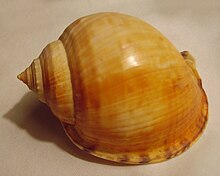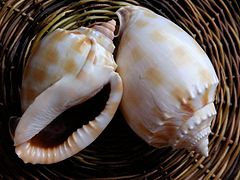唐冠螺科(学名:Cassidae)[1]:171,亦作冠螺科,是一个腹足纲软体动物的科,其物种为中型到大型、甚至很大型的海螺[2]。旧属中腹足目及异腹足目,今属玉黍螺类支序鹑螺总科[2][3]。
本科现时有约60个物种,例如:万宝螺(Cypraecassis rufa)。
命名
若按唐冠螺属的学名来命名,本科的学名应作“Cassididae”,但这样就会跟另一种甲虫分类龟金花虫科 的学名Cassididae Stephens, 1831 (基于Cassida Linnaeus, 1758,金花虫科物种,但现时已降格成为龟金花虫亚科)相冲。所以ICZN根据Opinion 1023 (1974, Bulletin of Zoological Nomenclature 31: 127-129),接受了现时的学名,以避免重复命名的出现[2]。
分布
本科物种分布于热带海域及温带的潮间带,水深可达100米。日间会埋在海底的沙里,到晚上才出来活动。
形态特征
本物种螺壳的手性均为右旋。体型通常很大。螺厣长圆形,薄而且有尖刺,能完全覆盖其长长的壳口。水管沟直或微弯。壳口外唇较厚,内里有齿。
解剖
本科物种的外套膜很大,腹足大而且厚肉。头部有可伸缩的长鼻,可协助捕食。眼睛在一对触角的基部。
食性
本科物种以棘皮动物(特别是海胆)为食:冠螺科物种的头部有长长的口器,连接两个大大的长鼻腺,可分泌出一种含丰富硫酸的分泌液[4]。冠螺会先用其腹足夹紧海胆,然后再分泌酸液在其外壳融解出一个洞,再从这个洞伸进齿舌去刮食海胆的肉[4]。
分类
在布歇特和洛克罗伊的腹足类分类 (2005年),作者依从Riedel (1995),唐冠螺科仍然被列作鹑螺科(Tonnidae Suter, 1913 (1825))之下的一个亚科(Cassinae Latreille, 1825)[3][5],直到Beu (2008)在他的著作《Revision of the deep-water Cassidae》才将本分类提升到科级层次[6][7]。
本科包括下列各属[2]:
- 唐冠螺亚科 Cassinae Latreille, 1825 == 卵螺亚科 Oocorythinae P. Fischer, 1885
- 鬘螺亚科 Phaliinae Beu, 1981
以下各属被认为是异名:
- Bathygalea Woodring & Olsson, 1957: synonym of Echinophoria Sacco, 1890
- Benthodolium Verrill & Smith [in Verrill], 1884: synonym of Oocorys P. Fischer, 1884
- Bezoardica Schumacher, 1817: synonym of Phalium Link, 1807
- Bezoardicella Habe, 1961: synonym of Phalium Link, 1807
- Cassidaria Lamarck, 1816: synonym of Galeodea Link, 1807
- Cassidea Bruguière, 1789: synonym of Cassis Scopoli, 1777
- Echinora Schumacher, 1817: synonym of Galeodea Link, 1807
- Euspinacassis Finlay, 1926: synonym of Echinophoria Sacco, 1890
- Hadroocorys Quinn, 1980: synonym of Oocorys P. Fischer, 1884
- Morio Montfort, 1810: synonym of Galeodea Link, 1807
- Taieria Finlay & Marwick, 1937: synonym of Galeodea Link, 1807
- † Trachydolium Howe, 1926: synonym of Echinophoria Sacco, 1890
- Xenogalea Iredale, 1927: synonym of Semicassis Mörch, 1852
- Xenophalium Iredale, 1927: synonym of Semicassis Mörch, 1852
图库
-
Galeodea rugosa
-
Semicassis granulata
人类使用
Some helmet shells are carved into cameos, starting in Italy in 1820.
- The king helmet Cassis tuberosa was the first species to be made into cameos.
- The black helmet Cassis madagascariensis, also known as Cassis cameo, has a dark brown or a claret-coloured shell layer under a yellowish outer layer. This gives it an onyx appearance and makes it one of the most useful shells for cameos.
- The red helmet Cypraecassis rufa gives a sardonyx-like appearance because it has sard-coloured bands under its pale outer coating.
- The horned helmet Cassis cornuta produces a white figure on an orange background. It is also used as a trumpet by native Filipinos.
参考文献
外部链接
Wikiwand in your browser!
Seamless Wikipedia browsing. On steroids.
Every time you click a link to Wikipedia, Wiktionary or Wikiquote in your browser's search results, it will show the modern Wikiwand interface.
Wikiwand extension is a five stars, simple, with minimum permission required to keep your browsing private, safe and transparent.







